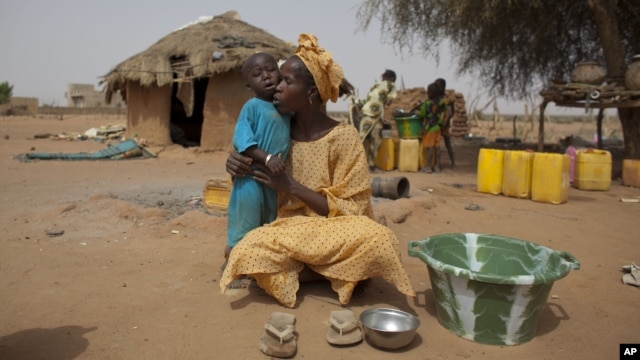
Lisa Schlein
Friday, January 25, 2013

Maryam Sy comforts her 2-year-old son Aliou Seyni Diallo, the youngest of nine, after a neighbor gave him dry couscous to stop him from crying with hunger, May 1, 2012.
GENEVA — The U.N. Children's Fund is appealing for $1.4 billion in 2013 to meet the immediate, life-saving needs of tens of millions of children gripped by conflict, natural disasters and other complex emergencies in 45 countries and regions. As in previous years, most of these emergencies are in Sub-Saharan Africa.
Two emergencies are grabbing most of the headlines these days -- Syria and Mali. The U.N. Children’s Fund says the new year has brought nothing but suffering and hardship for millions of Syrian children. Many are homeless within their own country. Others have been forced to flee to neighboring countries in search of refuge.
The United Nations estimates about 60,000 people have been killed since the popular uprising began in Syria nearly two years ago. UNICEF says more than half of the approximately 2.5 million people in need of assistance are children. It says providing the children with water, food, health care and education are among the priority needs.
As for Mali, UNICEF’s Director of the Office of Emergency Programs, Ted Chaiban, expressed great concern about the situation of children in the north, where the fighting between militant Islamist rebels and the government is ongoing.
He notes children in northern Mali are displaced, out of school and subject to violations including recruitment into armed groups and violence. But, Chaiban says it is important to remember that the majority of the population lives in the South. He says the needs there are great.
“What is happening now comes on the heels of a food insecurity crisis in 2012, where malnutrition was one of the key issues that needed to be addressed. In 2012, UNICEF and partners reached 40,000 children with treatment for severe acute malnutrition and we intend now to triple that to 125,000 children, or about 70 percent of the total caseload,” explained Chaiban.
Most of UNICEF’s operations are not found in high profile countries, such as Syria and Mali. More than 85 percent of the agency’s funding requirements are for humanitarian situations in places such as Chad, Colombia, Ethiopia, the Philippines,and Yemen.
Chaiban says UNICEF cares for children in highly challenging and largely forgotten emergencies around the world. Many of these countries are found in Sub-Saharan Africa, where the bulk of the appeal is centered.
Last year, Somalia was UNICEF’s largest humanitarian operation. The country no longer has to contend with the devastating drought that hit the Horn of Africa in 2012, nor does it have to deal with high levels of conflict. So funding requirements this year have gone down from $162 million to $141 million. Nevertheless, Somalia remains the biggest operation.
Besides addressing basic needs, Chaiban says some of UNICEF’s focus in Somalia this year will be on early recovery projects to help support and stabilize the population. He says the humanitarian situation in the Democratic Republic of Congo is also of concern, particularly in the east.
“Generally, you have got about one million children in DR Congo that are malnourished. It is the equivalent to the situation in the Sahel, but it is frequently unreported," Chaiban said. "At the beginning of this year, we were and still are very concerned about the situation in the Central African Republic with what was then the advance by Seleka on Bangui and we hope that the political process reveals a solution, which does not result in further displacement. And, the situation, of course, in the two areas of Sudan -- Blue Nile and South Kordofan.”
UNICEF says contributions to its programs this year will allow the organization to build on the work it began in 2012. It says some of the results achieved between January through October 2012 include the immunization of more than 38 million children, the provision of water, sanitation and hygiene to more than 12 million people, improved education for three million children and treatment for two million severely and acutely malnourished children.